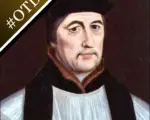
On this day in Tudor history, 12th November, Queen Jane Seymour’s remains were taken from Hampton Court Palace to Windsor Castle for burial (1537); and Stephen Gardiner, Bishop of Winchester, “Wily Winchester”, died (1555)…
[Read More...]
On this day in Tudor history, 12th November, Queen Jane Seymour’s remains were taken from Hampton Court Palace to Windsor Castle for burial (1537); and Stephen Gardiner, Bishop of Winchester, “Wily Winchester”, died (1555)…
[Read More...]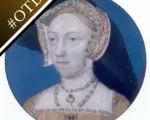
On this day in Tudor history, 24th October, Queen Jane Seymour, Henry VIII’s third wife, died at Hampton Court Palace; and John White, governor of the Roanoke Colony, returned to England after failing to find the lost colonists…
[Read More...]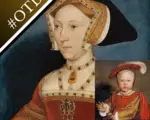
On this day in Tudor history, 12th October, Edward VI, son of Henry VIII and Jane Seymour, was born (1537); and MP and administrator Lewis Owen was murdered on a Welsh mountain pass as a result of his campaign against outlaws (1555)…
[Read More...]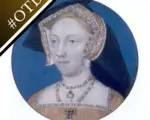
On this day in Tudor history, 11th October, Henry VIII and Anne Boleyn set sail from Dover for Calais for a meeting with Francis I (1532); and there was a solemn procession with prayers for Queen Jane Seymour, who was in labour (1537)…
[Read More...]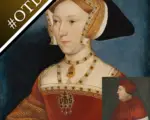
On this day in Tudor history, 3rd October, Cardinal Thomas Wolsey sang a mass to Henry VIII and the French ambassadors at St Paul’s Cathedral to celebrate a treaty between England and France; and imperial ambassador Eustace Chapuys wrote to Charles V informing him that Jane Seymour’s coronation was being postponed…
[Read More...]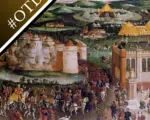
On this day in Tudor history, 7th June, the Field of Cloth of Gold meeting between Henry VIII and Francis I began; a water pageant was held in honour of Jane Seymour: and Elizabeth I’s former physician was hanged, drawn and quartered…
[Read More...]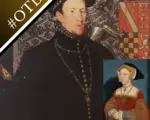
On this day in Tudor history, 2nd June, Henry VIII’s third wife, Jane Seymour, made her first appearance as queen; rebels including Sir Francis Bigod were executed in the aftermath of the Pilgrimage of Grace; and Thomas Howard, 4th Duke of Norfolk, was executed…
[Read More...]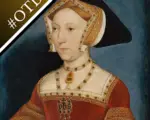
On this day in Tudor history, 1st April, Chapuys, the imperial ambassador, reported that Henry VIII had sent Jane Seymour a purse of money; physician William Harvey, who discovered the circulation of blood, was born; and author and soldier Thomas Churchyard died…
[Read More...]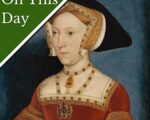
On this day in Tudor history, 20th May 1536, just 24 hours after Anne Boleyn’s execution, Henry VIII became betrothed to Jane Seymour, Anne’s former maid of honour.
The imperial ambassador Eustace Chapuys wasn’t impressed by Jane, describing her as medium height, “no great beauty”, “rather pale”, inclined to be “proud and haughty” and lacking wit. Her age and length of time at court also made him doubt whether she was a virgin! He did like the fact that she was sympathetic to Mary’s cause though – phew!.
[Read More...]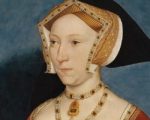
As this week has been the anniversary of Jane Seymour giving birth to Edward VI. I thought I’d share with you these expert talks on Jane Seymour from the Tudor Society archives…
[Read More...]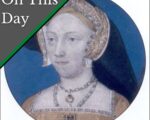
On this day in Tudor history, 11th October 1537, in the reign of King Henry VIII, London was praying for the king’s third wife, Queen Jane Seymour.
Jane was in labour with her first and only child, and the labour was long and difficult. On 11th October 1537, there was a solemn procession in the city of London to pray for her. After about thirty hours, Jane gave birth to a healthy baby boy, who would become King Edward VI.
Let me share some contemporary sources about the procession and Jane’s labour…
[Read More...]On this day in Tudor history, 20th May 1535, Pope Paul III made John Fisher, Bishop of Rochester, Cardinal-Priest of San Vitale, and arranged to have his cardinal’s hat sent to him.
The pope hoped that this would save Fisher, who was imprisoned at the time, from further punishment, but it made the king even more determined to behead Bishop Fisher. Oh dear!
Find out more about what happened…
[Read More...]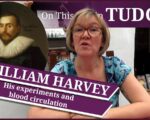
On this day in Tudor history, 1st April 1578, English physician William Harvey, was born in Folkestone, Kent. Harvey has gone down in history as being the man who discovered the circulation of blood, and he was also physician extraordinary to King James I and King Charles I.
How did Harvey work out that the heart pumped the blood around the body and how was his challenge of Galen’s work received?
Find out more about William Harvey’s work, and also his role in the pardoning of women accused of witchcraft, in this…
[Read More...]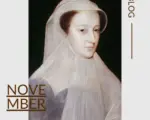

On this day in Tudor history, 24th October 1590, John White, the governor of the Roanoke Colony, returned to England after failing to find the lost colonists, which included his daughter, Ellinor (Elenora), his son-in-law, Ananias Dare, and his granddaughter, Virginia Dare.
But what happened to these colonists and what did the word CROATOAN carved onto a post mean?
Find out all about the Roanoke Colony and the theories regarding the disappearance of all 115 people, including the very latest research, in this talk…
[Read More...]
On this day in Tudor history, 11th October 1532, King Henry VIII and Anne Boleyn, the newly created Marquess of Pembroke, set sail from Dover aboard the king’s ship, The Swallow.
They were off to Calais on a mission involving the Great Matter, Henry VIII’s quest for an annulment. But why? What would they do there? Who would they meet?
Find out more about this trip, what happened and what happened next…
[Read More...]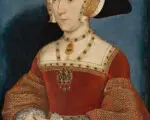
On this day in Tudor history, 3rd October 1536, imperial ambassador Eustace Chapuys wrote to Emperor Charles V informing him that Jane Seymour’s coronation was being postponed.
Several dates for Henry VIII’s third wife’s coronation are mentioned in the contemporary sources, but they all passed by without the coronation taking place, and building work on Westminster Palace in preparation for the coronation came to a halt.
Why wasn’t Jane Seymour crowned when her predecessor, Anne Boleyn, had been given a lavish coronation?
Find out more about what happened in 1536 and 1537…
[Read More...]
May is the anniversary of the fall of Anne Boleyn in 1536 and the rise of Jane Seymour, the month of two queens.
Test your knowledge on Henry VIII’s third wife with this fun crossword puzzle.
Simply click on the link or image below to open and print out.
[Read More...]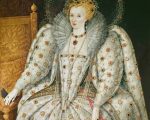

This Valentine’s Day a very special announcement was made by Prince Harry and his wife Meghan, they are expecting a child. A royal baby announcement nowadays is made and spread on social media. Since Instagram and other online platforms did not exist in Tudor times, how was this joyous news shared with the rest of the country?
[Read More...]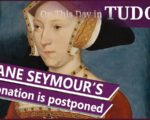
On this day in Tudor history, 3rd October 1536, imperial ambassador Eustace Chapuys wrote to Emperor Charles V informing him that Jane Seymour’s coronation was being postponed.
Several dates for Henry VIII’s third wife’s coronation are mentioned in the contemporary sources, but they all passed by without the coronation taking place, and building work on Westminster Palace in preparation for the coronation came to a halt.
Why wasn’t Jane Seymour crowned when her predecessor, Anne Boleyn, had been given a lavish coronation?
Find out more about what happened in 1536 and 1537 in today’s talk.
[Read More...]
On this day in Tudor history, 7th June 1536, there were celebrations for England’s new queen, Jane Seymour, third wife of King Henry VIII.
The celebrations consisted of a river pageant on the River Thames in London, from Greenwich Palace to Whitehall (York Place).
Find out all about this river pageant in today’s talk.
[Read More...]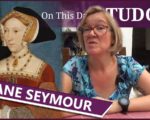
On this day in Tudor history, 2nd June 1536, Jane Seymour made her first public appearance at Greenwich Palace.
She’d married King Henry VIII on 30th May 1536, and this public appearance was just two weeks after Anne Boleyn’s execution, so it must have caused quite a stir.
Find out more about this public appearance, and also about Jane Seymour herself, in today’s talk.
[Read More...]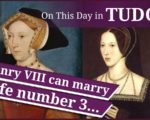
On this day in Tudor history, 19th May 1536, Queen Anne Boleyn was executed within the confines of the Tower of London.
It must have been an incredibly hard day for the queen’s friend, Archbishop Thomas Cranmer. Not only did he have a visit from a friend regarding a terrifying vision, in the early hours… Not only did he have to cope with the idea of his friend and patron being beheaded, but he had to issue a dispensation for the king to marry again!
Find out more in today’s talk.
[Read More...]
On this day in Tudor history, 12th November 1537, the corpse of Queen Jane Seymour, Henry VIII’s third wife, was transported by chariot in a procession from Hampton Court Palace to Windsor Castle, in preparation for burial. Jane Seymour’s heart and entrails had been buried in the chapel at Hampton Court Palace following her death on 24th October 1537.
Queen Jane’s stepdaughter, the Lady Mary, acted as chief mourner for the proceedings.
There was also a commemoration for Queen Jane in the city of London.
[Read More...]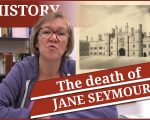
On this day in Tudor history, 24th October 1537, Queen Jane Seymour, third wife of Henry VIII, died at Hampton Court Palace twelve days after giving birth to a son who would grow up to be King Edward VI.
In today’s talk, I share contemporary accounts of Jane Seymour’s illness and death, as well as details of how her remains were prepared for burial and where they were buried.
[Read More...]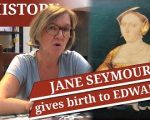
On this day in Tudor history, 12th October 1537, the eve of the Feast of St Edward the Confessor, Queen Jane Seymour, third wife of King Henry VIII, gave birth to a baby who would become King Edward VI.
Edward VI was born at Hampton Court Palace after a long and difficult labour. London celebrated the birth of England’s new prince, but, of course, happiness would soon turn to grief as Jane died on 24th October 1537.
In today’s talk, I share contemporary sources of Edward VI’s birth and the subsequent celebrations, and also talk about the myth that Edward VI was born by caesarean (c-section).
[Read More...]
On this day in Tudor history, 11th October 1537, poor Jane Seymour was in labour with her first and only child, Edward VI.
It was a long and difficult labour, and on 11th October, there was a solemn procession in the city of London to pray for her. After about thirty hours, Jane gave birth to a healthy baby boy, who would become King Edward VI.
In today’s talk, I share contemporary sources about the procession and Jane’s labour.
[Read More...]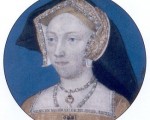
On this day in Tudor history, Tuesday 30th May 1536, just eleven days after the execution of his second wife, Queen Anne Boleyn, King Henry VIII married his third wife, the woman he thought of as his true love and true wife, Jane Seymour.
Find out more about this event and the bride and groom in today’s video.
[Read More...]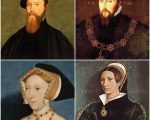
The Seymour family was a very important family in the reigns of Henry VIII and Edward VI, but just how much do you know about them? Grab a coffee and snack, and settle down to test your knowledge with this fun quiz. Good luck!
[Read More...]